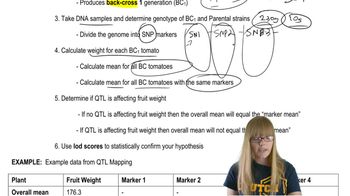How can you tell if two genes are epistatic?
Table of contents
- 1. Introduction to Genetics51m
- 2. Mendel's Laws of Inheritance3h 37m
- 3. Extensions to Mendelian Inheritance2h 41m
- 4. Genetic Mapping and Linkage2h 28m
- 5. Genetics of Bacteria and Viruses1h 21m
- 6. Chromosomal Variation1h 48m
- 7. DNA and Chromosome Structure56m
- 8. DNA Replication1h 10m
- 9. Mitosis and Meiosis1h 34m
- 10. Transcription1h 0m
- 11. Translation58m
- 12. Gene Regulation in Prokaryotes1h 19m
- 13. Gene Regulation in Eukaryotes44m
- 14. Genetic Control of Development44m
- 15. Genomes and Genomics1h 50m
- 16. Transposable Elements47m
- 17. Mutation, Repair, and Recombination1h 6m
- 18. Molecular Genetic Tools19m
- 19. Cancer Genetics29m
- 20. Quantitative Genetics1h 26m
- 21. Population Genetics50m
- 22. Evolutionary Genetics29m
3. Extensions to Mendelian Inheritance
Epistasis and Complementation
Problem 1
Textbook Question
How did geneticists determine that inheritance of some phenotypic characteristics involves the interactions of two or more gene pairs? How were they able to determine how many gene pairs were involved?
 Verified step by step guidance
Verified step by step guidance1
Geneticists observed that some phenotypic traits did not follow Mendel's simple 3:1 or 9:3:3:1 ratios in offspring, suggesting that more complex inheritance patterns were at play. They hypothesized that these traits might involve interactions between two or more gene pairs.
To test this hypothesis, they performed controlled breeding experiments using model organisms (e.g., pea plants, fruit flies) and analyzed the phenotypic ratios in the offspring. Deviations from Mendelian ratios indicated the involvement of multiple genes.
They used dihybrid and trihybrid crosses to study how different gene pairs interacted. For example, they looked for evidence of epistasis, where one gene masks or modifies the expression of another gene, and recorded the resulting phenotypic ratios.
By comparing the observed phenotypic ratios to theoretical ratios predicted by different genetic models, they were able to infer the number of gene pairs involved. For instance, a 9:7 ratio in a dihybrid cross suggests complementary gene action involving two gene pairs.
Further confirmation came from molecular studies, where geneticists identified the specific genes and their interactions at the DNA level, providing direct evidence of how multiple gene pairs contribute to a single phenotypic trait.
 Verified video answer for a similar problem:
Verified video answer for a similar problem:This video solution was recommended by our tutors as helpful for the problem above
Video duration:
2mPlay a video:
Was this helpful?
Key Concepts
Here are the essential concepts you must grasp in order to answer the question correctly.
Polygenic Inheritance
Polygenic inheritance refers to the phenomenon where multiple genes contribute to a single phenotypic trait. This means that traits such as height, skin color, and eye color are influenced by the additive effects of several gene pairs, rather than being determined by a single gene. Understanding this concept is crucial for grasping how complex traits are inherited and expressed in organisms.
Recommended video:
Guided course

Organelle Inheritance
Quantitative Trait Loci (QTL)
Quantitative Trait Loci (QTL) are specific regions of the genome that are associated with the variation in a quantitative trait. Geneticists use QTL mapping to identify which genes are involved in the inheritance of traits by analyzing the correlation between genetic markers and phenotypic variations. This method allows researchers to estimate the number of gene pairs influencing a trait and their relative contributions.
Recommended video:
Guided course

QTL Mapping
Statistical Analysis in Genetics
Statistical analysis plays a vital role in genetics, particularly in determining the number of gene pairs involved in trait inheritance. Techniques such as regression analysis, ANOVA, and linkage analysis help geneticists assess the relationship between genotype and phenotype. By analyzing data from breeding experiments and population studies, researchers can infer the genetic architecture of traits and the interactions between multiple genes.
Recommended video:
Guided course

Chi Square Analysis
Related Videos
Related Practice
Multiple Choice
865
views
1
rank
1
comments


